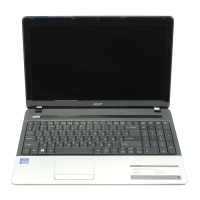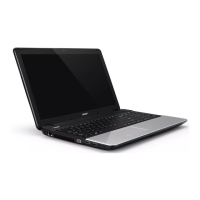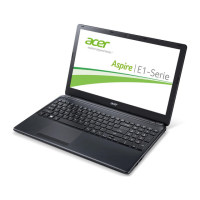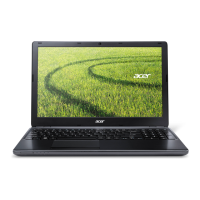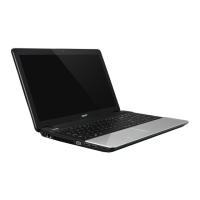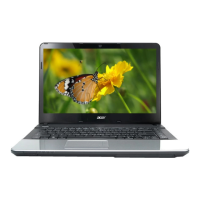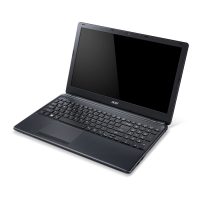Do you have a question about the Acer Aspire E1-532 and is the answer not in the manual?
Instructions on safely powering down the computer before cleaning to prevent damage or electrical hazards.
Guidelines for ensuring the power outlet is accessible and how to properly unplug the power cord for safety.
Procedures for safely connecting and disconnecting the power supply unit, including handling multiple power sources.
Operating the product from the correct power source and safety precautions regarding the power cord.
Warnings and advice on preventing hearing damage from prolonged use of earphones or headphones at high volumes.
Explains the purpose of plastic dummies in card slots for protection from dust and particles.
Advises against self-servicing and recommends referring all servicing to qualified personnel due to risks.
Crucial safety guidelines for using the Lithium-ion battery, including environmental and temperature precautions.
Instructions on how to safely replace the battery pack and warnings about using non-compliant batteries.
Safety warnings and guidelines for turning off wireless devices to prevent interference with other electronics and medical devices.
Information on potential interference between radio transmitting equipment and medical devices, advising consultation with physicians.
Recommendations for maintaining a safe distance between wireless devices and pacemakers to avoid interference.
Notes potential interference between digital wireless devices and hearing aids, advising consultation with service providers.
Discusses RF signal interference with vehicle electronic systems and safety precautions for using the device in vehicles.
Advises switching off the device in potentially explosive atmospheres like gas stations or chemical plants to prevent ignition.
Informs users that emergency calls cannot be made through the device and to use a mobile phone instead.
Provides guidance on the proper recycling and disposal of electronic devices to protect the global environment.
Information regarding mercury content in certain product components and disposal requirements.
Explains the benefits of ENERGY STAR qualified products for energy saving and environmental protection.
Offers advice on ergonomic setup and work habits to prevent physical strain and discomfort during computer use.
Tips for adjusting the workstation setup (monitor angle, seating) to achieve maximum comfort and prevent strain.
Suggestions to reduce eyestrain from long viewing hours, including resting eyes and blinking.
Recommends developing good work habits like taking breaks and stretching to make computer use more relaxing and productive.
Safety warnings regarding the laser system in the optical drive and avoiding direct exposure to the laser beam.
Introduces the various guides available (Setup Guide, Quick Guide, User's Manual) to help users get started.
Provides fundamental advice on maintaining the computer and using it effectively for daily operations.
Step-by-step instructions on how to properly power on and shut down the computer using Windows commands.
Essential guidelines for maintaining the computer's condition and preventing damage from environmental factors or mishandling.
Instructions on how to properly handle and maintain the AC adapter to ensure its longevity and safe operation.
Advice on how to care for the battery pack, including proper usage, replacement, and disposal methods.
Procedures for safely cleaning the computer, including what to do if the computer is dropped or malfunctions.
Identifies and describes the key components visible on the computer's screen and surrounding bezel area.
Details the layout and function of the computer's keyboard, including the power button and touchpad.
Identifies and describes the ports and connectors located on the left side of the notebook.
Provides specific details and characteristics of USB 3.0 ports, including their color and compatibility.
Identifies and describes the ports and drive bays located on the right side of the notebook.
Identifies and describes the components located on the bottom (base) of the notebook.
Explains the functionality of lock keys like Caps Lock, Num Lock, and Scroll Lock on the keyboard.
Details the various hotkey combinations (Fn key + function keys) used to control computer functions like brightness and volume.
Describes the specific functions of the Windows key and the Application key for operating system navigation.
Explains how the touchpad functions as a cursor control device and basic gestures for interaction.
Details various multi-finger gestures supported by the touchpad for enhanced navigation and control in Windows 8.
Step-by-step guide on creating a system recovery backup, crucial for restoring the computer to its original state.
Instructions on backing up essential drivers and pre-installed applications for system restoration.
Outlines methods for system recovery, including reinstalling software/drivers or reverting to previous states.
Procedures for reinstalling pre-installed applications and device drivers from the hard drive or created backups.
Explains how to use System Restore points to revert the system to a previous stable state.
Details the process of resetting the computer to its original factory settings when other recovery methods fail.
Guides users on how to perform system recovery operations directly from within the Windows operating system.
Step-by-step instructions for performing a full factory reset using Acer's recovery tool.
Explains how to perform a custom restore that attempts to retain user data while reinstalling the OS and drivers.
Instructions on how to restore the system using a previously created recovery backup on a USB drive.
Detailed steps for resetting the PC to factory settings using a recovery backup.
Guide for refreshing the PC from a recovery backup, retaining personal files while reinstalling system software.
Instructions on how to turn off the Fast Startup feature to potentially save power and reduce battery drain.
Describes the general characteristics of the battery pack and its charge-in-use functionality.
Provides instructions on how to charge the battery pack, including optimal times for charging.
Details the process of conditioning a new battery pack for optimal charge acceptance and lifespan.
Offers tips and suggestions to maximize the battery's operational life and efficiency.
Explains how to monitor the current battery charge level using the power meter icon.
Advises on actions to take when the battery-low warning appears to prevent data loss.
Step-by-step instructions for safely installing and removing the computer's battery pack.
Lists the steps required to safely disconnect the computer from external accessories and peripherals.
Provides basic advice for moving the computer over short distances, such as within an office.
Steps to prepare the computer for movement, including using Sleep mode or shutting down.
Recommendations on essential items to bring to meetings, such as the AC adapter if needed.
Guidance on preparing the computer for transit between office and home, including packing advice.
Lists essential items to bring when transporting the computer, like the AC adapter and setup guide.
Additional tips for protecting the computer during travel, focusing on temperature changes and condensation.
Suggestions for enhancing a home office setup, such as using a second AC adapter or external peripherals.
Advice for moving the computer over larger distances, including airport security procedures.
Specific guidance for international travel, including power adapter compatibility and customs requirements.
Explains how to use a Kensington-compatible security slot and cable to physically secure the computer.
Details the types of passwords (Supervisor, User) and their role in protecting the computer and data from unauthorized access.
Describes the process of entering passwords when prompted and the consequences of incorrect attempts.
Explains how to connect the computer to an Ethernet-based network using the RJ-45 port.
Guides on connecting the computer to wireless networks and the internet, including setup steps.
Defines wireless LAN (WLAN) and its benefits for mobility and sharing resources.
Highlights the ease and speed of setting up a wireless LAN system without cables.
Lists the necessary components for setting up a wireless network at home, such as an access point.
Describes the function of access points (routers) as mediators for wired and wireless network connectivity.
Explains how to configure the boot sequence within the BIOS utility for starting the computer.
Details how to set up boot passwords via the BIOS utility to enhance system security.
Troubleshooting steps for when the computer does not start or boot up, focusing on the power indicator.
Solutions for when nothing appears on the screen, including checking brightness and external display settings.
Troubleshooting steps for issues related to sound output, including volume levels and speaker connections.
Advice for when the keyboard fails to respond, suggesting checking connections or contacting support.
Basic troubleshooting steps to resolve issues where the printer is not functioning correctly.
Information on obtaining service and warranty support, including the International Travelers Warranty (ITW).
Information required when contacting Acer support for troubleshooting and service.
General advice and strategies for effectively troubleshooting system problems using onscreen error reports.
A guide to common error messages and their corresponding corrective actions for resolving system issues.
Introduces core concepts of Windows 8 like Start, Tiles, and Charms for new users.
Instructions on how to access the Windows 8 Charms bar and navigate to the Start screen.
Guides on switching between apps, turning off the computer, and understanding the new interface.
Steps for personalizing the computer, including changing backgrounds, moving tiles, and customizing the lock screen.
Information on closing apps, changing screen resolution, and accessing the traditional desktop in Windows 8.
Instructions on how to install apps from the Store and locate pre-installed applications.
Explains Microsoft accounts and how to add favorites in Internet Explorer by pinning shortcuts to Start.
Guidance on checking for Windows updates and resources for further information.
Details compliance with FCC limits for Class B digital devices, addressing potential radio frequency interference.
Notices regarding the use of shielded cables and certified peripheral devices for FCC compliance.
States compliance with Canadian digital apparatus standards (ICES-003, RSS-210).
Informs about potential minor pixel variations on the LCD screen that do not constitute a malfunction.
Regulatory information for wireless LAN and Bluetooth devices, including indoor use restrictions.
Acer's declaration of compliance with EU directives for the computer.
Information on wireless operation channels and frequency band restrictions in different regions, particularly France.
Lists countries where the equipment may be operated and specific Canadian radio communication device regulations.
Details compliance with Health Canada limits for RF field exposure from low-power devices.
Further details on compliance with Canadian radio standards, including indoor use restrictions for specific frequency ranges.
Explains FCC RF safety requirements, including minimum separation distances for wireless antennas to minimize human exposure.
| Storage | 500 GB HDD |
|---|---|
| Graphics | Intel HD Graphics |
| Operating System | Windows 8 |
| RAM | 4 GB DDR3 |
| Display | 15.6" HD (1366 x 768) |
| Battery | 4-cell Li-ion battery |
| Weight | 2.35 kg |
